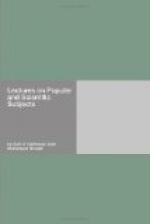When vegetable matter is excluded from air and under great pressure, it decomposes slowly, parting with carbonic acid gas; and is first changed into lignite or brown coal, and then into bituminous coal, or the soft coal that burns with smoke and flame. I have been in a coal-mine where the carbonic acid gas, pouring from a crevice in the coal, put out a lighted candle. The high temperature to which the coal has been subjected when buried at great depths has also probably assisted in producing this change; and where that temperature has been very high, the coal by the influence of the heat having parted with its inflammable gases, we have the hard or anthracite coal, which burns with little or no flame and without smoke. It is indeed coal made into coke under tremendous pressure, and this is the kind of coal which Americans use exclusively in their dwelling-houses and monster hotels.
It was at first supposed that the plants of the carboniferous times were bamboos, palms, and gigantic cactuses, such as are now found in tropical regions, but a more careful examination of them shows that, with the exception of the tree-fern now found in the tropics, they differ from all existing trees. A large proportion of the plants of the coal-measures were ferns, some authorities say one-half. From their great abundance we may infer the great heat and moisture of the atmosphere at the time when they grew, as similar ferns at the present day are only found in the greatest abundance on small tropical islands where the temperature is high. Coal often contains impressions of fern leaves and palm-like ferns—no less than 934 kinds are drawn and described by geologists. Many animals and insects are found in the coal, such as large toad-like reptiles with beautiful teeth, small lizards, water lizards, great fish with tremendous jaws, many insects of the grasshopper tribe, but none of these are of the same species as those found now living on this globe.
Wood, peat, brown coal, jet, and true coal, are chemically alike, differing only in their amount of oxygen, due to the difference of compression to which they were subjected. The sun gave his heat and light to the forests now turned into coal, and when we burn it ages afterwards, we revive some of the heat and light so long untouched. Stephenson once remarked to Sir Robert Peel, as they stood watching a passing train: “There goes the sunshine of former ages!”
COST OF WORKING.
Having thus stated shortly the origin and extent of the coal of this country, more particularly that of the northern coal-fields of Northumberland and Durham, I think it may be interesting to say something of the cost at which this valuable article is obtained, as I am sure few are at all aware of the vast sums of money that have to be expended before we can sit down by our comfortable firesides, with a cold winter night outside, and read our book, or have our family




